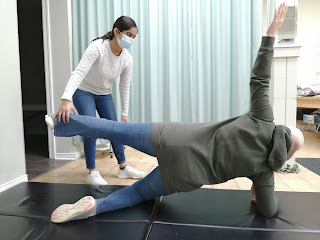Importance of Scapular stabilization exercises in shoulder injury
To begin.
It is essential to understand a little biomechanics of shoulder joint.
Shoulder joint is a complex joint consists of 3 joints made up of 3
bones: Humerus (Arm bone), Clavicle (collar bone) and Scapula (shoulder blade).
[ we will be mainly focusing on the shoulder blade]. All these joints have to
work in syc with one another to do any movement in the shoulder. Thus, raising
the arm above head, giving a full range of 180 degrees, involves synchronous
movement of arm bone and shoulder blade and is termed as scapulothoracic
rhythm. Commonly accepted ratio is 2:1 where, 2 degree occurs at Arm bone and 1
degree occurs at shoulder blade.
Collar bone(clavicle) also rotates to some degrees to provide flawless movement in shoulder. But lets not go in depth and just concentrate on shoulder blade for now!!
Movements that occurs
in shoulder blade (above figure):
1.
Elevation/Depression.
2.
Abduction/adduction.
3.
Upward
rotation/downward rotation.
To do all these movements, it is of utmost importance that the muscles of shoulder blades are strong and of appropriate length. If the shoulder blade is unable to do move smoothly along with arm (either because of weak or tight muscle) then there are high chances of getting soft tissue injuries like rotator cuff tear, sub-acromian bursitis, bicipital tendonitis etc.
Even in frozen shoulder, shoulder dislocation or after surgical procedures in arm or around shoulder joint,
research shows that if shoulder blade movement is restored first then there are
less chances of re-occurrence and soft tissue injury around shoulder joint.
Sports which involves over head
activities or skillful maneuvers of arm or as a beginner in a gym it is of
highly advisable to strengthen the weak shoulder blade muscles and stretch the
tight shoulder blade muscles to keep it moving smoothly and avoid injuries.
How physiotherapy can help
As said earlier, there are many
muscles that involved in smooth movement of shoulder blade. Now, some of this
muscle may be weak, or tight or disuse due to prolonged pain. Therefore, it is
recommended to get assessment done where a physiotherapist can find the
postural deformity in shoulder blade by careful observation and with different
tests determines the root cause of deformity and address problems with
appropriate treatment.
Treatment includes like myofascial
release, MET, mobilization which are done manually by the physiotherapist.
Myofascial release helps to loosen up the muscles by carefully gliding of hands
long the muscle. To release some muscles it might not be a pleasant experience
because of its attachment but it gets job done. MET is Muscle Energy Technique,
a unique technique which can loosen the tight muscle, strengthen the weak
muscle and also increase joint mobility. It uses contraction-relaxation as well
as manual lengthening procedures in pain free range. Mobilization is gliding
the bone over rib cage.
Another important part of physiotherapy treatment
is exercise which includes stretching, strengthening and activation of the
muscles. Stretching is done to loosen the tight muscles. Strengthening is done
either by using patients own body weight or with different equipment like free
weights, resistant band or tubes. Muscle activation exercises are done for
disuse muscles which is a way of recruiting the muscle to perform its function. It is about establishing mind body connection.
Shoulder is the most mobile joint of our body which makes stability much more important. People with shoulder problems will tell you that it is absolutely a big life hindrance to be unable to move their arms high up. Let's all work on the shoulder blades and prevent shoulder problems!
References
·
Carolyn
Kisner, Lynn Allen Colby: Therapeutic exercise foundation and techniques, 5th
edition, 2007.
·
John
Gibbons: Muscle energy techniques a practical guide for physiotherapist, 2013.




Comments
Post a Comment